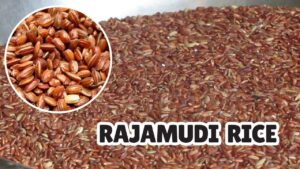Comparison: Difference between Kullakar Rice and Poongar Rice:
Two traditional rice varieties from India, particularly Tamil Nadu, are Kullakar rice and Poongar rice. Both of them have their own distinct features, nutritional value and cultural importance. Discover the key difference between Kullakar rice and Poongar rice, highlighting their unique health benefits and uses.
Kullakar Rice
Kullakar rice, or Kullangar rice (as it is often called), is regarded as a parboiled short grained rice that is distinct in taste and aroma. This rice is predominantly grown in the Sivagangai district of Tamil Nadu using organized agricultural practices and organic farming. For this reason, the rice does not contain harmful compounds and pesticides.

Nutritional Benefits:
- High in Dietary Fiber: Would be beneficial to the digestive system and could help in reducing cholesterol levels.
- Rich in Essential Minerals: Includes calcium, potassium, iron, zinc and phosphorus among others which are crucial for the bones and proper body functions.
- Low Glycemic Index: People suffering from diabetes would find it useful as it does not create a high surge in blood sugar levels.
- Gluten-Free: People who are sensitive to gluten or have celiac disease can have this weight in moderation.
Culinary Uses:
Kullakar rice is a versatile grain and can be cooked in many ways to prepare different dishes such as idli, dosa, puttu, khichdi, salads and biryani.
Poongar Rice
Also called “Women’s Rice’’ and because of this rice’s relationship to women’s health, it is oftentimes associated with women’s rice and such grains mostly have thick and hardy texture being cultivated mainly in a particular region of Tamil Nadu. Slipping through traditions Poongar rice like Kullakar rice is popular and caters to culture’s a lot of diets.

Health Benefits:
- Hormonal Balance: Aims to assist females in hormonal distribution regulation.
- Rich in Nutrients: Composition that is a myriad of minerals and vitamins promoting a healthy body.
- Complex Carbohydrates: Supplies energy but assist a gradual, low peak in blood sugar.
Recipe and Preparation:
Many utilize Poongar rice to recreate dishes made out of Kullakar rice but majority use it for the purpose of nutrition relevant to women’s health.
Comparison Table: Kullakar Rice vs Poongar Rice
| Feature | Kullakar Rice | Poongar Rice |
|---|---|---|
| Grain Type | Short-grain | Varies (often medium to long-grain) |
| Nutritional Focus | High fiber, low glycemic index | Hormonal balance for women |
| Primary Minerals | Calcium, potassium, iron | Various vitamins and minerals |
| Culinary Uses | Idli, dosa, biryani | Traditional dishes emphasizing health |
| Cultivation Method | Organic farming | Often organic but varies by producer |
The Health Benefits of Kullakar Rice and Poongar Rice
Poongar rice and Kullakar rice are ancient traditional rice varieties that have their origins from Tamil Nadu, India, and they are considered to have a potent dietary as well as health effect. The two can be used independently or combined in meals. Here is a detailed look at the health benefits of each.
Health Benefits of Kullakar Rice
1. Nutritional Profile:
Kullakar rice is abundant in some of the essential macro as well as micronutrients such as –
- Dietary Fiber: It supports digestive health and control body weight settled by hunger since it suppresses appetite.
- Vitamins and Minerals: It supplies a range of necessary minerals for the body including iron, calcium and magnesium which performs several functions in the body.
2. Low Glycemic Index:
Kullakar rice is suitable for diabetic patients. A low glycemic index (GI) of Kullakar rice enables releasing energy at a slow rate thus supporting stabilization in blood glucose level post consumption of food.
3. Gluten-Free:
Because of the genetic composition of this rice variety, this rice is gluten-free and celiac patients have a perfect alternative in this rice.
4. Antioxidant Properties:
Kullakar rice contains antioxidants that help tackle oxidative stress within the body and reduce the chances of getting chronic diseases including cancer and heart disease.
5. Heart Health:
Since Kullakar rice is rich in fiber, there is a possibility that the cholesterol levels will drop, bolstering heart health and minimizing the chances of cardiac problems.
Health Benefits of Poongar Rice
1. Rich in Antioxidants:
Poongar rice is particularly appreciated because of its reddish brown hue which comes from it having the richest anthocyanins among all varieties of rice. These antioxidants help the body against free radicals thereby lowering the risk of chronic diseases such as cancer and heart problems.
2. Hormonal Balance:
In fact, the grain is often informally called ‘women’s rice’ because it is said to balance women‘s hormones, particularly during pregnancy and lactation. Thus, they advise its consumption to expectant and nursing mothers since it enables healthy pregnancy and lactation.
3. High Iron Content:
Additionally, Poongar rice has a high abundance of iron. Iron is essential as it prevents anemia and aids in red blood cell production. Intake on a regular basis can assist in raising the amount of hemoglobin in the blood.
4. Diabetes Management:
Like Kullakar rice, poongar rice has low glycemic index as well and thus does not allow a sudden spike in the blood glucose levels after a mean. They are thus useful for all diabetics. It also assists in the control of cholesterol levels, which is critical for metabolic health in general.
5. Digestive health:
In Particular, the high content of fiber in Poongar rice enhances digestion, encourages normal bowel movements, and helps in the prevention of constipation. This makes it useful among people suffering from digestive disorders such as Irritable Bowel Syndrome (IBS).
6. Provision of Immune system:
Poongar rice has vitamins and minerals that help in boosting the immune system of the body increasing tolerance to infections and diseases.
These two types of rice (Kullakar rice and Poongar rice) highlight health benefits that make them worth integrating into a healthy diet. Kullakar rice is especially useful for the patients who want to opt for low-GI foods as it advocates good heart and digestive health, whereas Poongar rice is more renowned for its properties supporting antioxidant activities and for being beneficial to women during pregnancy and breastfeeding. These diasporic rice types can be included in everyday diets to improve nutritional status and enhance general health.
Must Read,
✔️ Rajamudi Rice: Health Benefits, Nutritional Value, Cooking Method
✔️ Rice Mill Business: Starting a Rice Mill in India
Conclusion: Difference between Kullakar rice and Poongar rice
In Tamil Nadu, Kullakar rice and poongar rice are important food components. Both have different nutritional values and can be supplemented in a number of traditional dishes. Kullakar rice is known for its advantages for diabetics while poongar rice can be used for women’s health benefits. One’s choice between the two options can be determined by health factors or one’s need for taste.






